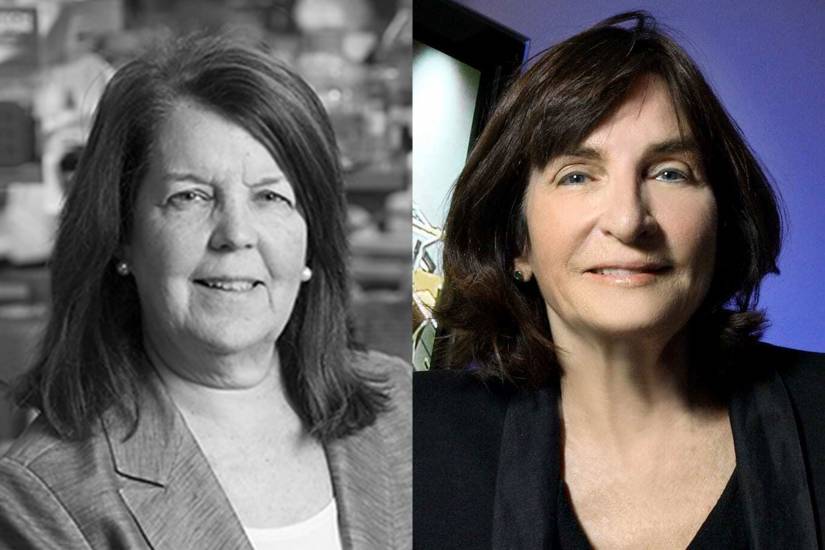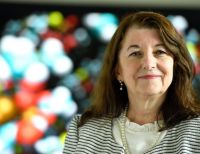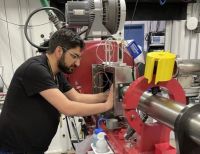In a slate blue folder, the German physician Alois Alzheimer compiled detailed notes on his patient, a 50-year-old housewife named Auguste Deter. "She sits on the bed with a helpless expression," he wrote. She could recall her name was Auguste, but she thought that was also her husband's name. When faced with memory tasks, she grew frustrated and despondent. "I have lost myself," she said.
Michela Gallagher
JHU professor of neuroscience
"I think we will be able to relegate Alzheimer's disease to the history books. If we can slow the progression of Alzheimer's well before it is diagnosed, you could give people decades and decades of their lives back."
Deter had arrived at a Frankfurt psychiatric hospital in 1901 after her husband was no longer able to manage her confusion, fits of rage, and forgetfulness. Her condition continued to deteriorate until her death five years later. When Alzheimer examined Deter's brain tissue, he discovered something remarkable: unusual plaques and tangles of protein in and around her neurons. Alzheimer presented his findings at a medical conference later that year describing it as "a peculiar severe disease process of the cerebral cortex."
Alzheimer's disease, as it came to be called, is now recognized as the most common form of dementia. Alzheimer's washes away a person, much as an ocean's waves erode the shore. First there are minor lapses in memory—misplaced keys, a forgotten movie title—followed by difficulties in planning and making decisions. Then there are changes in personality, mood swings, bursts of anger. Eventually, the disease sweeps away the very core of a person: the ability to talk, to recognize loved ones, even to move. About 6 million people in the U.S. currently have the disease, a number expected to rise exponentially as the baby boomers age. In addition to the immense suffering each case represents for the patient and their loved ones, the cost to the economy is staggering. Alzheimer's and other forms of dementia cost the United States a projected $306 billion last year, far greater than the costs of treating cardiovascular disease or cancer.
There is currently no cure for Alzheimer's, and the few drugs that have been approved to treat the disease have had mixed results. But what if there were a way to slow the progression of the disease, to still the ocean as the first waves lap the shore? Two renowned Johns Hopkins researchers, neurology Professor Marilyn Albert, the director of the Johns Hopkins Alzheimer's Disease Research Center, and neuroscience Professor Michela Gallagher, are in the late stages of testing a drug that appears to do just this. If the drug clears all the regulatory hurdles, it will be approved for patients in the earliest stages of Alzheimer's, when symptoms are mild. The pair is hopeful the drug will receive FDA approval within the next five years.
"I think we will be able to relegate Alzheimer's disease to the history books," Gallagher says. "If we can slow the progression of Alzheimer's well before it is diagnosed, you could give people decades and decades of their lives back. You could protect families from the horrendous protracted deterioration of a person over the course of the dementia phase."
The researchers believe that better diagnostic tools—which Albert is exploring in a separate research project—will also enable doctors to spot Alzheimer's before symptoms appear. "When you go to the doctor and they see you have high blood pressure or high cholesterol, they don't wait until you have a stroke to start treating you. They bring your blood pressure or cholesterol under control right away," Albert says. "We have made enormous progress in reducing strokes that way. It's the exact equivalent with Alzheimer's. Our goal is to be able to intervene when people are just beginning to be at risk."
Gallagher and Albert come to Alzheimer's research from different scientific perspectives. Gallagher, one of the first two women to attend Colgate University, initially studied art as a college student, but a lecture on visual perception awakened her interest in the brain, leading her to pursue a master's and a doctorate in physiological psychology, which focuses on the brain and its function. ("That was before neuroscience existed," Gallagher says with a laugh.) She has spent much of her career studying memory in animal models, examining healthy elderly rats and those that experience a cognitive decline as they reach the ripe old age of a year and a half. She also has a personal connection to Alzheimer's. Her mother died in 2003 after a lengthy struggle with the disease.
Albert, meanwhile, has devoted her career to observing aging in humans. She has been an author on about 300 scientific studies over the past four decades, with topics ranging from memory loss in alcoholics to changes in the brain in healthy aging. She currently leads a massive study known as Biomarkers of Cognitive Decline Among Normal Individuals, or BIOCARD, in which researchers are tracking the physical and cognitive changes of hundreds of people as they move from middle age to old age. The study began at the National Institutes of Health in 1995 but moved to Johns Hopkins under Albert's leadership in 2009. Participants undergo cognitive testing and have regular PET scans, MRIs, and analyses of their blood and cerebrospinal fluid to look for changes associated with Alzheimer's and normal aging.

"Michela and I have long been interested in the same questions, but we use different approaches to answer those questions," Albert says. "We have both been intrigued by the question of what is healthy aging and what is disease, and when the first signs of disease emerge."
Both researchers came to Hopkins about two decades ago, yet their professional collaborations stretch back much further. When Gallagher was a professor at the University of North Carolina at Chapel Hill and Albert was a professor at Harvard University, they appeared together at conferences around the world, often speaking on the same panels. Gallagher would discuss aging and rodents; Albert would talk about aging in humans.
The scientists' personalities complement each other. Gallagher's words pour out in a torrent, especially when she describes topics she is passionate about, such as the precise mechanism by which her Alzheimer's drug works. Albert is more measured. She has a knack for describing a complex neurological process in a few quiet words. Over the years, the scientists have developed a deep admiration for each other's work. "I have huge respect for what she has accomplished," Gallagher says of Albert. "We've been in neuroscience at a time when very few women were in the field."
When Albert and Gallagher began their research into memory, little was known about Alzheimer's. Researchers have made many discoveries about the disease's progression in the ensuing decades, but its origins remain shrouded in mystery. Age, of course, is the biggest risk factor, as the proteins that cause plaques and tangles take decades to accumulate. Most people are diagnosed with Alzheimer's in their mid-70s to mid-80s, though a small percentage of patients develop symptoms in their 40s or 50s. Having a close relative with Alzheimer's also means you are more likely to develop the disease, though actual genetics remains murky. One gene, APOE, which codes for a certain protein, affects risk for the disease. Those with a certain variant of the gene are more likely to develop Alzheimer's; those with a different variant of the gene almost never develop the disease.
Other risk factors include head injuries and cardiovascular disease. And then there are lifestyle choices. Studies suggest that people who remain intellectually, physically, and socially active in old age are less likely to develop Alzheimer's, so your friends and neighbors who are spending their advanced years hiking and attending lectures are onto something. Albert is an author of a study awaiting publication that indicates that people who are mentally active show certain positive changes in their neural pathways; those who are physically active demonstrate improvements in a different set of pathways. The results appear to be additive, so those who study Portuguese and learn pickleball in retirement may reap twice the benefits. "It looks as if these activities definitely make a difference," Albert says. "They change the risk."
Yet Gallagher points to her mother's story as proof that even those without risk factors can succumb to the disease. "My mother was an extraordinarily healthy woman," she says. "She had a master's degree, which was unusual for a woman of her generation. She was sharp as a tack. She had lots of friends. She used to walk a couple of miles on the beach every day. I do think that there are things that can increase your risk for Alzheimer's, but there are people getting this disease who otherwise have lived very healthy lives."
Gallagher had already been studying aging and the brain for decades before her mother's diagnosis. "It was this convergence of my work and my life," she says. "It was interesting, weird, and heartbreaking." Her mother's illness gave Gallagher an intimate understanding of the difficulty of caring for a loved one with Alzheimer's. "I developed an appreciation for the burden that so many people experience."
When Albert begins lectures on memory, she often shows a photograph of the brain of Henry Molaison, who was born in 1926 in Connecticut. When Molaison was a boy, he fell off his bicycle, suffered a head injury, and began experiencing seizures. As he reached adulthood, the seizures grew more intense and frequent, forcing him to leave his job on a factory line. In 1953, in an attempt to stop the seizures, neurosurgeon Henry Beecher Scoville at Hartford Hospital in Connecticut removed much of the medial temporal lobe on both sides of Molaison's brain, including the hippocampus and the amygdala.
The effects were immediate and devastating. Although Molaison's seizures grew less frequent, he became unable to form new memories. While Molaison could recall his childhood and most events prior to the surgery, he could not remember to whom he was talking, what he had done a few moments ago, or even his age. In 1968, researchers reported that Molaison described his perceptions as "like waking from a dream. Every day is alone in itself," he told them.
Molaison's personal tragedy led to great advances in the science of memory. Prior to this, scientists believed that memories were processed throughout the entire brain. By studying the experiences of Molaison (who was referred to as H.M. in medical literature prior to his death in 2008), neuroscientists were able to pinpoint the hippocampus and surrounding regions as crucial to the formation of new memories, what Gallagher refers to as our "memory-making machinery."
It is this same region of the brain that comes under attack when the first symptoms of Alzheimer's appear. People in early Alzheimer's have trouble forming new memories. For example, they may struggle to remember what they ate for breakfast. They may have a hard time recalling which neighbors they passed on their daily walk or repeat the same stories during a dinner party. Brain scans show that people in the earliest phases of Alzheimer's disease have suffered damage to the hippocampus and nearby regions.
Yet long before the hippocampus is damaged, the plaques and tangles that Alois Alzheimer first described are forming in the brain. These lesions are caused by two proteins essential to normal brain function: tau, which accumulates into tangles within cells, and amyloid, which forms plaques between cells. Johns Hopkins School of Medicine pathology and neurology Professor Juan Troncoso discovered that these proteins appear in the brains of people decades before they begin to show symptoms of Alzheimer's. Tau begins to build up in a person's late teens and 20s; amyloid begins to appear when people are in their 40s.
"The brain produces large amounts of these proteins, and then has to clear them out, [just] as we remove our trash and recycling at home," Troncoso says. "Over time, the clearance systems start to decline." While tangles of tau appear in the brains of people without any memory loss, they are more abundant and widespread in those with Alzheimer's. Amyloid appears only in the brains of those with Alzheimer's. "Amyloid can irritate the brain in many ways," Troncoso says. "The brain's response to irritation can cause further damage. That sounds scary, but the silver lining is that the time between the onset of these abnormalities and the onset of the disease is very long, about 20 years. So, you have ample time to prevent the disease."
In developing their yet-to-be-named drug, Gallagher and Albert focused on a mechanism related to the spread of amyloid and tau. When Albert was at Harvard, she discovered that hippocampal neurons in patients with early Alzheimer's were firing more than those of people without memory loss. This was a surprising finding; scientists had previously believed that neurons gradually grew less active before their deaths. Albert and her colleagues discovered that a period of hyperactivity preceded this decline.
Gallagher built upon Albert's research in her work with rodents. She discovered that elderly rats with cognitive losses also had hyperactive brain cells. She hypothesized that neurons of early Alzheimer's patients were losing the ability to inhibit their activity, much like a teacher who has lost control of a classroom of rowdy children. When everyone is yelling, you can't make out the words of a single person.
"There is a lot of inhibition in a healthy brain," Gallagher says. "There are neurons that suppress others so there isn't too much noise in the brain. Greater activation can make the brain work less efficiently."
Moreover, Gallagher hypothesized, this increased activity was pushing tau and amyloid to move throughout the brain, further accelerating the spread of plaques and tangles. Gallagher began looking for a drug that could quiet this activity. After extensive research, she identified a compound, levetiracetam, that calms these hyperactive brain episodes. Levetiracetam has been approved by the Food and Drug Administration to treat seizures in epilepsy patients, when used in conjunction with other medications.
For more than a dozen years, Gallagher has been leading the laborious process of testing levetiracetam for this new use. First, she spearheaded a study that showed that levetiracetam calmed hyperactivity in the hippocampi of elderly rats with memory impairment. Then in 2008 she received a $1.3 million grant from the National Institutes of Health to test the drug on human subjects. That study, published in Neuron in 2012, showed that levetiracetam quieted overactive neurons of people with mild memory loss, helped improve their performance on cognitive tasks, and caused no major side effects. The study also showed that levetiracetam had no effect on people who do not have Alzheimer's. In other words, it's not a magic pill that would provide memory superpowers to those who do not have the disease.
Gallagher created a company, AgeneBio Inc., to push the drug through the patenting and approval process. She devised a low-dose, time-released version of levetiracetam, dubbed AGB101. In 2018, the Alzheimer's Drug Discovery Foundation awarded Gallagher the Melvin R. Goodes Prize for Excellence in Alzheimer's Drug Discovery, a $150,000 award that she infused into her research as she embarked on a pivotal trial of AGB101. Albert serves as co-principal investigator on the study, and Hopkins colleagues from the Department of Psychiatry and Behavioral Sciences and the Bloomberg School of Public Health also contribute to the project. Albert's expertise in working with human subjects has been crucial to the success of the study, Gallagher says. "She's been at every meeting we've had with the FDA," she says.
While COVID-19 temporarily halted progress on the drug trial ("It's hard to ask elderly people to come in to get brain scans during a pandemic," Gallagher says), the researchers finished recruiting subjects in April. More than 164 people at 27 research sites across the country are taking the drug for 78 weeks as part of the trial. Preliminary results are expected in the fall of 2022.
AGB101 is taken as a single, time-release pill at breakfast time, Gallagher says, making it a more convenient therapy than Aduhelm, the Alzheimer's drug given conditional approval by the FDA this summer. The announcement of Aduhelm's approval was initially met with excitement as it is only the fifth drug approved to treat Alzheimer's—and the first in 18 years. However, many health experts raised concerns about the drug, saying the approval was premature. Like AGB101, Aduhelm is intended for people in the early stages of the disease. However, Aduhelm is administered as an intravenous infusion and costs about $56,000 per year. While the drug has been shown to reduce amyloid plaques, it's unclear whether it improves cognitive function. Aduhelm is more effective in clearing plaques in those with the APOE4 gene variant; it has also been associated with brain bleeds in some patients.
There are more reasons to be hopeful that a treatment for Alzheimer's is on the horizon. In addition to AGB101, there are 126 drugs currently being tested, according to the Alzheimer's Association.
Meanwhile, Albert's BIOCARD study continues to track 350 participants as they grow into old age. Albert is currently recruiting 150 new participants to join the study. She hopes that the project will provide physicians with the tools to identify Alzheimer's earlier, perhaps with a blood test, and begin preventive treatment before people experience memory loss.
Albert and Gallagher are confident that Alzheimer's will be seen as a preventable, treatable condition within a few decades. They are emphatic that people (and mice and monkeys for that matter) can age without developing significant cognitive declines. Medical students used to be taught that brain cells die as we age. We now know that is not true, Gallagher says. While some connections between neurons are lost in old age, studies have shown that even healthy nonagenarians have largely the same number of neurons that they had as young adults.
"We know not everyone has to deteriorate as they age," Gallagher says. "We see healthy aging in rats. We see it in monkeys. We see it in humans. As an academic, I could have just focused on this mechanism in the rat brain. Why work on a clinical trial? But I knew firsthand how devastating this disease is. It's such an exhausting and difficult journey, not just for the person with Alzheimer's but for their family and friends. I'm going to do everything I can to stop this disease."
Julie Scharper is a freelance writer in Baltimore.















